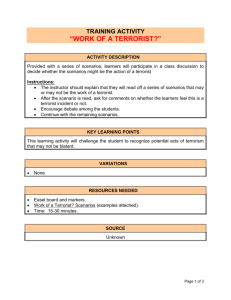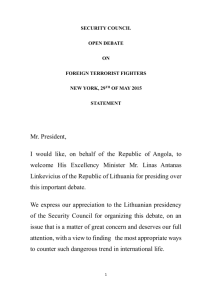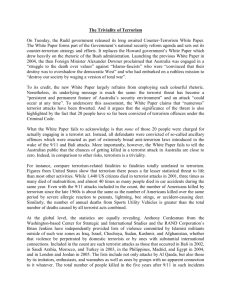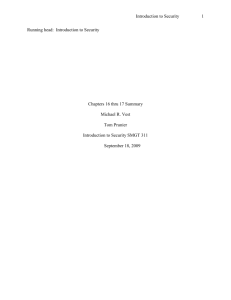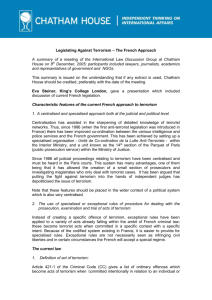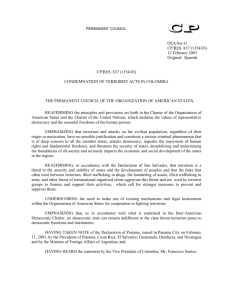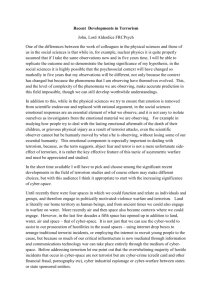APSA PAPER 1
advertisement
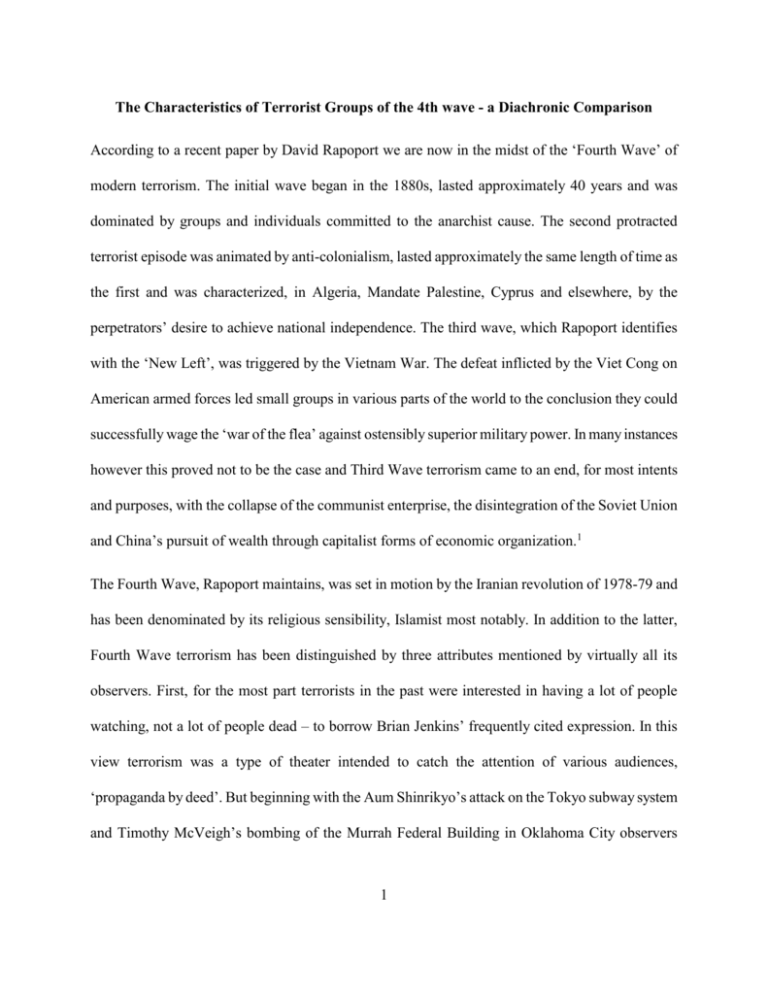
The Characteristics of Terrorist Groups of the 4th wave - a Diachronic Comparison According to a recent paper by David Rapoport we are now in the midst of the ‘Fourth Wave’ of modern terrorism. The initial wave began in the 1880s, lasted approximately 40 years and was dominated by groups and individuals committed to the anarchist cause. The second protracted terrorist episode was animated by anti-colonialism, lasted approximately the same length of time as the first and was characterized, in Algeria, Mandate Palestine, Cyprus and elsewhere, by the perpetrators’ desire to achieve national independence. The third wave, which Rapoport identifies with the ‘New Left’, was triggered by the Vietnam War. The defeat inflicted by the Viet Cong on American armed forces led small groups in various parts of the world to the conclusion they could successfully wage the ‘war of the flea’ against ostensibly superior military power. In many instances however this proved not to be the case and Third Wave terrorism came to an end, for most intents and purposes, with the collapse of the communist enterprise, the disintegration of the Soviet Union and China’s pursuit of wealth through capitalist forms of economic organization.1 The Fourth Wave, Rapoport maintains, was set in motion by the Iranian revolution of 1978-79 and has been denominated by its religious sensibility, Islamist most notably. In addition to the latter, Fourth Wave terrorism has been distinguished by three attributes mentioned by virtually all its observers. First, for the most part terrorists in the past were interested in having a lot of people watching, not a lot of people dead – to borrow Brian Jenkins’ frequently cited expression. In this view terrorism was a type of theater intended to catch the attention of various audiences, ‘propaganda by deed’. But beginning with the Aum Shinrikyo’s attack on the Tokyo subway system and Timothy McVeigh’s bombing of the Murrah Federal Building in Oklahoma City observers 1 detected a dangerous development. The new religiously-inspired terrorists wanted to kill as many people as they were capable of doing. Second, and obviously related to the first factor, the new terrorists were widely believed to be interested in developing weapons of mass destruction (WMD) or, at a minimum, chemical, biological, radiological and nuclear (CBRN) to enhance their capacity to engage in mass murder.2 Finally, ‘Fourth Wave’ terrorism has taken on a new organizational format. Earlier forms of terrorist organization, many observers contend, were highly centralized and strongly hierarchical in shape. The New Left or Third Wave Italian Red Brigades, for example, had a ‘ national directorate’ etc. that made it resemble one of the political parties with which it was engaged in ‘armed struggle’. From the American radical racist Louis Beam’s web site appeal for ‘leaderless resistance’ to the Al Qaeda Training Manual, contemporary practitioners of terrorism have promoted loosely-coordinated or networks of small groups as the most effective way of carrying out their missions and evading capture by the authorities. “Terrorism seems to be evolving in the direction of violent netwar. Islamic fundamentalist organizations like Hamas and the bin Laden network consist of groups organized in loosely interconnected , semi-independent cells that have no single commanding hierarchy.”3 Our general concern in this paper is with the attributes of terrorist organizations that were formed between 1910 and 2000, in other words with the pattern of organization of terrorist groups that span most of the era encompassed by Rapoport’s Four Waves. Our particular interest is in understanding how the present Fourth Wave organizations differ from their predecessors. But unlike Arquilla and his associates at Rand, we do not focus on changes in their shape or structural characteristics. Instead, we intend to investigate the following matters. First, we would like to know when and where terrorist organizations have been formed over the 2 course of this 90 year period. As a matter of frequency, in which decade(s) were most terrorist groups established? In this regard, how does the last decade of the 20th century compare with earlier periods? Geographically, on what continents are terrorist bands most likely to be formed? And how, if at all, has this distribution changed over time? Next, we are certainly interested in the ideological outlooks of terrorist groups and how the relative prevalence of each such orientation may have changed over time. As virtually everyone understands by now terrorism is a tactic, one that may be employed by groups with various political goals for varying lengths of time. For our purposes, we have classified groups into ones of left-wing, rightwing, nationalist and religious inspiration. In some cases telling the difference is not all that easy. For instance, over the course of its career in terrorism, the Croat group Ustacha articulated, successively fascist and later Marxist ideas about the role of its homeland. But of course its goal, despite the shifting rhetoric, was nationalist, an independent Croatia. Something similar might be said with respect to the Greek group November 17. Originally a Marxist-Leninist band committed to attacking the outposts of American imperialism in the Aegean in more recent years it has sought to defend its Greek Orthodox brethren in their struggles elsewhere in the Balkans.4 Despite these problems, we have been guided in classifying groups, based on their central or underlying tendencies, by our principal data source (see below). Third, we are curious about the relationship(s) between terrorist groups and other organizations. What types of links exist between groups which employ terrorist violence and states? How prevalent, for example, is state-sponsorship now and in the past? Also, on occasion terrorist groups are not stand-alone organizations. Instead they may have ties to political parties of one kind or another. The links between the IRA and Sinn Fein in Northern Ireland and Batasuna and ETA in the Spanish 3 Basque country are well-known. We would like to know how frequent these links have been and, further, are they more common among Fourth Wave groups than their predecessors? Finally, we are curious about the existence of ties between one terrorist group and another. Do terrorist groups cooperate with one another and how often does such cooperation occur? And, are the terrorist groups formed in the 1990s more likely to cooperate with one another than earlier decades? Recent news reports suggest growing cooperation in Lebanon between Hezbollah and Al Qaeda militants. Is this an isolated phenomenon or a frequent behavior? Data and Methodology In order to answer these exceptionally intriguing questions, we have done the following, information about the characteristics of terrorist organizations was obtained from Schmid and Jongman’s compilation of terrorist groups.5 More contemporary information was found in The United States State Department’s Patterns of Global Terrorism project.6 These combined sources provide valuable sketches of the different terrorist organizations that emerged throughout the world since the beginning of the 20th Century. Both our sources, especially Schmid and Jongman list not only terrorist groups, but also include state agencies involved in the repression of political dissent and protest. Other entries describe rural guerrilla organizations, revolutionary movement and various other groups opposed to the prevailing political order none of which include terrorism in their repertoire of insurrectional techniques. In the analysis that follows two criteria were applied in identifying terrorist groups. If a group was labeled as either terrorist or urban guerrilla it was included; if a group’s reported activities encompassed assassinations, bombings, kidnapping, or skyjacking, either threatened or carried out, 4 which were intended to achieve some political purpose, one wider than simply harming the immediate target, it, too, was included. Using the latter standard death squads in Latin America and elsewhere were also included. However, groups that seemed to be subsidiary units of larger organizations were not included. In those cases where a group(s) changed its name(s) with every attack or several attacks, only the original or more general label was used as the basis for identification. Of the 2,197 groups and organizations described by Schmid Jongman et al. and the 45 mentioned at the Patterns of Global Terrorism database, a total of 399 were identified as terrorist organizations using these criteria. Two stages took place during the coding of the data. First, a qualitative database was created. This database included all the information available about each organization. Then, this data was coded for the following independent variables: the organization’s name; the year the organization was established; the country and the continent in which the organization originated; the organization’s ideology;7 the relationship, if any with a sponsoring organization.8 Also coded was the organization’s relationship, if any, with a sponsoring country9 or with a political party.10 The Establishment of Terrorist Organizations Figure 1 around here First, we wanted to trace the organizations’ developmental pattern and especially the number of organizations established in each decade. The early 20th century was characterized by the establishment of a small number of organizations. However, this tendency changed in the 1960s, with an increased growth rate of terrorist organizations. The growth peaked in the 1970s and 1980s when 137 and 122 new organizations respectively were established. The establishment of fewer 5 organizations in the 1990s can be attributed to few factors. 11 First, from the 1960s through the 1990s internal splits within many of the left-wing and nationalist organizations drove a dramatic increase in the number of organizations established. Internal division is not as common among the religious organizations that were mainly established in the 1980s and 1990s, hence the emergence of fewer groups than the 1960s-1990s.12 Second, the end of the cold war also ended the creation of new leftwing organizations.13 The Geographical Dispersion of Terrorist Organizations Figure 2 around here Table 1 around here Figure Two presents the number of organizations established in different parts of the world during the 20th century. The graph indicates that Europe was clearly the center for terrorist organization formation followed in order by South America, the Mid-East, Asia and North America. A close look at Table 1 indicates that although Europe has been the center for terrorist organizations, this was focused between the 1950s and 1980s. In South America, terrorist organizations first appeared in the 1950s, flourished through the 1960s, and declined since then. In the Middle East, the first appearance of terrorist organizations was in the 1960s.14 New terrorist organizations, mainly Palestinian, were formed in 1970s. In the 1980s terrorist organization formation spread to other parts of the Middle East. A further look at Table 1 indicates that during the 1900s and in North America the establishment of new terrorist organizations was sporadic and came in waves. In other parts of the world, new organizations began to emerge in only after the middle of the century, becoming an integral, and enduring, part of each continents political scene. 6 The Changing Ideologies of Terrorist Organizations Figure 3 around here Just as the geographical spread terrorist organizations has changed, so too has their ideological distribution. Figure 3 indicates that a left-wing ideology was the most prominent ideology among terrorist organizations in the 20th century. A closer look at the graph illustrates that since the beginning of the 1950s nationalist organizations became more visible. Nationalism, as the organizations ideological premise, peaked in the 1970s and has declined since then. Right-wing organizations first appeared in the 1920s and 1940s, ascending during the 1950s and peaking in number in the 1980s. This finding reflects the re-emergence of right-wing extremist parties in Europe in the last few decades. The most interesting finding, however, is the connection of terrorist organizations to religion. Although religious groups represent the smallest number of groups in this study, it should be noted that while virtually no new organizations, of a nationalist, left, or right-wing nature, were established in the 1990s, religious organizations continued to emerge: 71.4 percent of the organizations established in the 1990s were religious ones. Connections between Terrorist Groups and Countries Figure 4 around here Prior to the discussion of the findings which are presented in figure 4, it should be noted that with regard to the whole population of terrorist groups in our data set only 13.5 percent of the groups were found to have connections to sponsoring countries. It is especially interesting to note that the stateterrorist groups connection developed in a linear line beginning in the 1950s and peaking in the 1980s. In the 1990s no such connections appeared. Hence, we may deduce that connections between 7 countries and terrorist groups and more specifically the phenomenon of State Sponsored terrorism is a trait of former waves of terrorism but not of the fourth one. Connections between Terrorist Groups ad Political Parties Figure 5 around here With regard to connections between terrorist groups and political parties we found that out of the whole populations of organizations 31 percent had some connection to a political party. However, despite the fact that such connections were mostly widespread between the 1950s and 1980s the line here is not linear. In other words, connections between terrorist groups and political parties are visible throughout the whole 20th century yet they became more common between the 1960s and 1980s and most prominently in the 1970s. Connections between Different Terrorist Groups Figure 6 around here As for the connections between different terrorist groups, only 36.1 percent of the groups in this study had such connections. In terms of waves it is highly interesting the very much like the connections between terrorist groups and political parties, here too this is mainly a phenomenon of the 1960s till the 1980s which peaked in the 1970s. Nonetheless this phenomenon still exists in the 1990s, yet in more moderate figures. 8 Discussion and Conclusions The data we have managed to assemble and analyze permit us to respond to the questions posed at the beginning of this paper. Our task is easier if we simply reduce the questions we raised to one: How does Fourth Wave terrorism differ from earlier manifestations of the phenomenon? First, compared to the 1970s and 1980s, Third Wave terrorism in other words, there has been a significant reduction in the formation of new terrorist groups during the 1990s. In terms of the geography involved, a high proportion of the new fourth wave groups were formed in Africa, including North Africa, and South Asia, parts of the world with large and growing Muslim populations. Fewer new groups however does not necessarily mean better from the point of view of the authorities. A large number of small fragmented organizations, such as was typical of the New Left era, may pose less of a challenge than a comparative handful of groups with many adherents operating on the basis of ‘netwar’ tactics. Second, it seems to us a bit of a misnomer to identify Fourth Wave terrorism with religion in general. The various millennial groups or ‘doomsday cults’ which pre-occupied the FBI and other law enforcement organizations at the turn of the 21st century have largely fizzled at least as terrorist threats. Instead of ‘forcing the end’ or using terrorist attacks to promote the ‘Tribulation’, most of these groups have rarely used terrorism or, to the extent they employed it, directed the violence against their own members – as with followers of the Heaven’s Gate organization. Aum Shinrikyo, once a major menace in Japan and elsewhere, currently presents itself as the East Asian equivalent of the Society of Friends. It seems indisputable that there has been a narrowing in the ideological outlook of terrorist groups as 9 we move from the Third to the Fourth Wave. During the former period terrorism attracted groups with a heterogenous collection of political orientations, left-wing revolutionary, nationalist, rightwing reactionary etc. Fourth Wave terrorism has been dominated not by groups inspired by religious views in general but more specifically by ones holding an Islamist understanding of the world.15 In fact, to the extent non-Islamist terrorist organizations appear during the Fourth Wave, they tend not to be religious in character but nationalist (e.g. ETA) and revolutionary (e.g. FARC) leftovers from the previous era. A third way in which contemporary terrorist organizations differ from their predecessors concerns their links to other entities. Here we are obviously dependent upon ‘open source’ information (see the earlier discussion of our data base). Covert relationships may exist of which we are unaware. But so far as our data suggest, contemporary terrorist groups appear much more autonomous than their Third Wave predecessors. Groups formed during the 1990s were significantly less likely to enjoy state-sponsorship than those that emerged during the Cold War era. Not only has the Soviet bloc disappeared but such long-standing terrorism supporting states as Libya and the Sudan have apparently gone out of the business. In addition, despite the current cooperation between Al Qaeda and Hezbollah in Lebanon, on balance our evidence indicates that Fourth Wave groups have less to do with one another than the Third Wave ones. Here, we should remember that a high proportion of the latter shared a revolutionary outlook, one that promoted solidarity between European groups and various Third World ones. Such joint operations as the skyjacking of an Air France jetliner by a PLO and German Red Army Fraction band in 1976 (the Entebbe affair) or the skyjacking of a Lufthansa airliner two years later by the same organizations are illustrative. We may say approximately the same with respect to the relationship between political parties and 10 terrorist groups. Such ties are not completely a thing of the past. Hezbollah, for example, is an organization that carries out terrorist attacks from time-to-time while competing successfully at Lebanese elections. Also, in Spain Batasuna continues to act as the ‘political wing’ of ETA. Nevertheless, during the Third Wave a large number of terrorist groups regarded themselves as belonging to a Marxist-Leninist or Trotskyite family. Belonging to this revolutionary family often meant the relevant groups defined themselves as acting on behalf of a vanguard party, e.g., the People’s Revolutionary Army in Argentina, Peru’s Shining Path.16 Contemporary Islamist groups, on the other hand, have no such organizational commitments. In any case, political party – terrorist group linkages are less common in the Fourth than the Third Wave of terrorist activity. Threat assessment, particularly after the events of September 11, has become a big business. We conclude this discussion by offering a brief, cost-free threat assessment of our own. Fourth Wave terrorism is distinguished from its immediate predecessor in being at once less complex from both organizational and ideological perspectives but more dangerous. The danger resides, of course, in the often indiscriminate nature of the violence. Instead of selective assassination of potentates or the ‘knee-capping’ of particularly despised members of the bourgeoisie, the stock-in-trade of earlier groups, contemporary terrorism has often become an exercise in mass murder. We may derive some comfort though from Rapoport’s observation that each of the preceding terrorist waves lasted about one generation, a few decades. If this pattern holds true for the present wave, we are now experiencing its downside. But of course what follows the end of the Fourth Wave remains to be seen. David Rapoport, “ Modern Terror: The Four Waves” Current History (December 2001) pp. 419-425; A revised version of this paper was presented at the annual conference of the 1 11 International Society of Political Psychology in Berlin, July 16-19, 2002. 2 The literature is enormous but see for example, Bruce Hoffman, Inside Terrorism (London: Victor Gollancz, 1998) ad passim; Mark Juergensmyer, Terror in the Mind of God (Berkeley: University of California Press, 2000) ad passim; Walter Laqueur, The New Terrorism (New York: Oxford University Press, 1999) ad passim. John Arquilla, David Ronfeldt, and Michele Zanini, “Networks, Netwar, and Information-Age Terrorism,” in Ian Lesser et. Al., Countering the New Terrorism (Santa Monica, CA: Rand Corporation, 1999) p. 56. 3 4 For a discussion see Walter Laqueur, Terrorism (Boston: Little, Brown, 1977) pp. 196- 197. 5 Schmid, Alex, P & Jongman et al. Political Terrorism, Amsterdam, North-Holland Publishing, 1988. 6 Office of the Coordinator of Counter Terrorism; http://www.usis.usemb.se/terror. The data in this source was cross checked with others. The impressionistic conclusion is this is the most reliable and comprehensive contemporary source. 7 Ideology is coded as 1 left wing; 2 nationalist-separatist; 3, religious; 4 right wing. 8 This is coded in a binary fashion, yes, no. 9 This, too, is a binary code, yes, no. 10 Again, binary, yes, no. The data for the 1980’s and 1990’s is drawn from a source different than that for the prior years, introducing a possible source bias. A cross checking of each data set against organizations, in the 1990’s lead us to conclude if a bias exists, which we doubt, the consequence is marginal. 11 12 See for example, Walter Laquer, The New Terrorism (New York, Oxford University Press, 1999) p127-155; and Michel W Zanini, The Making of Terrorism (Chicago, University of Chicago Press, 1988) pp 147-216. 13 The vaguely structured right-wing groups, arising from the violent subculture of the 1980's fall outside our definition of terrorist organizations, and are not included in this data base. 14 This observation excludes three organizations founded in the 1930's, the Stern Gang and Irgun in Palestine, and the KHL in Lebanon. 15 For recent accountings along these lines see Paul Wilkinson’s list of terrorist groups 12 produced by the British government. Paul Wilkinson, “ Active Terrorist Groups” Aviation Security 7:3 ( June 2001) pp. 18-24. Or, for the American perspective see Patterns of Global Terrorism 2001 (US Department of State, May 2002) pp. 85-130. See, for example, Richard Gillespie, “”Political Violence in Argentina: Guerrillas, Terrorists and Carapintadas,” in Martha Crenshaw (ed.), Terrorism in Context (University Park, PA: Pennsylvania State University Press, 1995) pp. 211-248. 16 13


